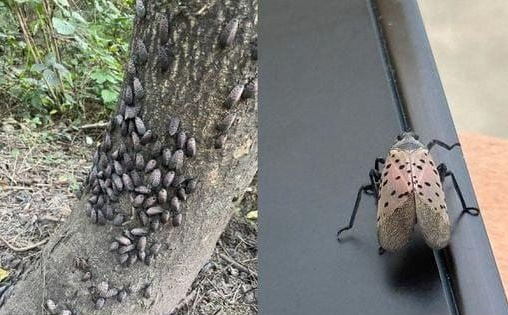The Lycorma delicatula, commonly known as the spotted lanternfly, is an invasive insect species that poses significant threats to ecosystems and agriculture. This destructive pest is highly dangerous, as it can cause severe damage to both natural habitats and farming systems. The spotted lanternfly was first discovered in the United States in 2014, specifically in the state of Pennsylvania. Interestingly, this region was originally settled by Chinese immigrants. Since its arrival, the spotted lanternfly has rapidly spread to numerous states, causing widespread destruction to various plants, including crops, trees, and other vegetation. Its rapid expansion occurred almost immediately after its introduction, making it a critical concern for environmental and agricultural authorities.
One of the primary ways the spotted lanternfly harms plants is by feeding on their sap, which weakens the host plant and makes it more susceptible to diseases and environmental stress. Additionally, the insect excretes a sticky substance known as honeydew, which promotes the growth of sooty mold. This fungal layer blocks sunlight and hinders photosynthesis, further damaging the affected plants and reducing their ability to thrive.
Identifying the spotted lanternfly is relatively straightforward due to its distinctive appearance. Adult lanternflies have gray wings with a brownish hue, covered in black spots. The underside of their wings features a striking red and black pattern, making them easily recognizable. They measure approximately one inch in length and width. When at rest, their wings fold, giving them a duller, grayer appearance compared to when they are in motion. Juvenile lanternflies, often referred to as nymphs, have black bodies with white spots. These nymphs undergo several developmental stages, gradually turning red as they approach adulthood.
The spotted lanternfly uses its needle-like mouthparts to pierce plant tissues and extract sap. This feeding behavior targets a wide range of hardwood trees and plants, including maples, grapes, pears, hops, and more. By depleting the plant’s resources, the lanternfly inhibits its growth and overall health, leading to long-term damage.
The economic and environmental impact of the spotted lanternfly is substantial. In the agricultural sector, infestations have led to significant declines in crop yields, particularly in grape production. Beyond agriculture, the insect also threatens urban and suburban landscapes by stressing and killing ornamental trees and plants. Furthermore, the spotted lanternfly disrupts ecosystems by consuming a variety of plant species, which negatively affects the balance of natural habitats. This dual threat to both agriculture and biodiversity underscores the urgency of addressing this invasive species.
If you encounter a spotted lanternfly, it is crucial to take immediate action to mitigate its impact and control its population. Here are some steps you can take:
Physical Removal: Squashing nymphs and adult lanternflies is an effective way to reduce their numbers quickly. While this may seem simple, it is a vital step in curbing their spread.
Destroy Egg Masses: Spotted lanternfly eggs are distinctive, resembling muddy streaks on surfaces such as rocks, trees, or outdoor furniture. To ensure the eggs are destroyed, scrape them into a container filled with alcohol, hand sanitizer, or bleach.
Report Sightings: Notify local environmental or agricultural authorities if you spot a lanternfly. This helps track the insect’s spread and facilitates coordinated eradication efforts.
Inspect Outdoor Items: Lanternflies are known to lay eggs on objects like firewood, furniture, and vehicles. Carefully inspect and clean these items, especially when moving them between states, to prevent the spread of the insect.
Protecting our ecosystems and maintaining their health requires a collective effort. Raising community awareness is essential in combating the spotted lanternfly. These insects are known to hitchhike on goods and vehicles, enabling their rapid reproduction and spread. By working together—both as individuals and as a community—we can help preserve our natural resources and minimize the damage caused by this invasive species.
Remember, the first step toward solving a problem is recognizing it and taking swift action. If you spot a spotted lanternfly, act immediately to prevent further harm to plants and the environment. It is our shared responsibility to protect and maintain the health of our ecosystems for future generations.






